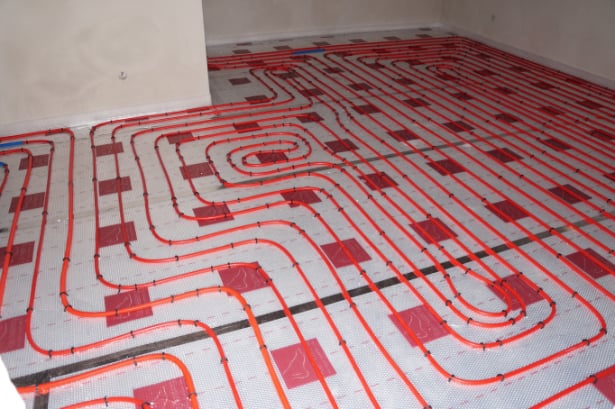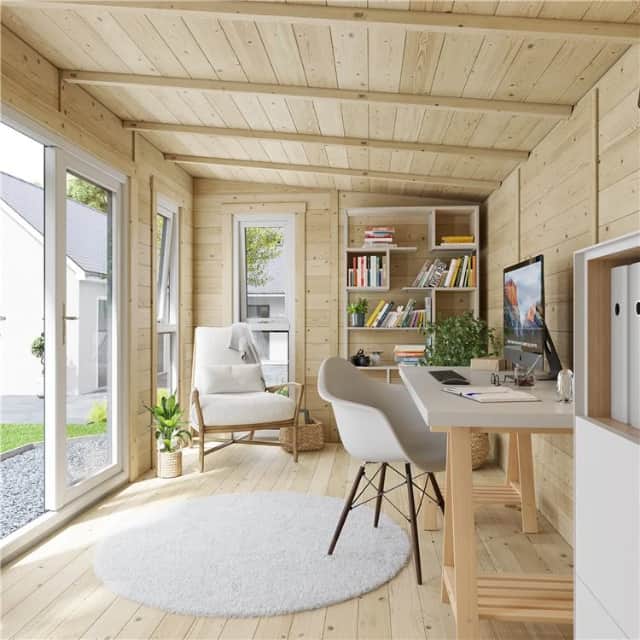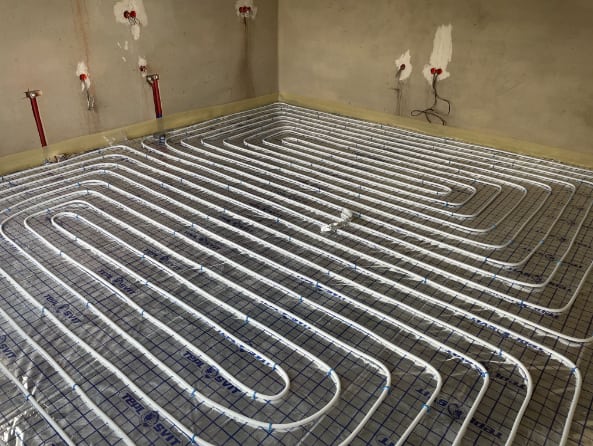Jump to:
One of the best ways to heat your log cabin is through underfloor heating. This method provides comfortable and controllable heat where it’s most needed. However, before you decide to install it, there are a few factors you need to consider. This guide will cover these conditions to help you determine if it’s a viable option.
What Is Underfloor Heating and How Does It Work?

(Image Credit: Wikimedia Commons)
As the name suggests, underfloor heating is a system installed beneath the floor surface. It operates by generating heat that rises from the floor and warms up the room. This alternative is more energy-efficient and cost-effective than traditional radiators.
Your garden log cabin may benefit from underfloor heating if you wish to use it year-round, especially during winter. Then again, there are some criteria that need to be met.
Considerations for Underfloor Heating Installation in Your Log Cabin

- Is your log cabin insulated? Timber, the primary material of log cabins, is more susceptible to moisture. If not protected, this can damage the heating system underneath and the cabin itself. Dampness can also occur if the structure lacks ventilation. To avoid these risks, ensure you look into insulating your log cabin by the same principles as a summer house, and properly ventilate it. Alternatively, you could buy an insulated log cabin with pre-installed ventilation. Read our guide, ‘Insulated Log Cabins: Everything You Need to Know,’ to learn more.
- Is your log cabin stable and capable of supporting the added weight of the heating system? A stable structure ensures an even heat distribution across the floor surface. An underfloor heating system also comes with pipes or heating mats, insulation materials, and so on, which add to the load. Your garden room must be robust enough to support this extra weight. Consult the manufacturer’s guidelines to understand the unit’s technical specifications. Or better yet, enlist professionals to ensure proper installation of the system.
- What type of underfloor heating will you choose? The installation requirements depend on your choice. Two options are available: electric underfloor heating and water underfloor heating.
What Is Electric Underfloor Heating?

(Image Credit: Wikimedia Commons)
One option for heating your log cabin is electricity. Electric underfloor heating uses thin wires that heat the floor surface when turned on. This type of heating is laid directly under the floor covering or into the tile adhesive. It’s easy to operate, install, and fit and is suitable for all types of floor coverings.
However, keep in mind that installation costs can be expensive due to the components it requires to function. These include heating cables or mats, insulation boards, and thermostats. Larger log cabin rooms need more heating and may involve more complex installation techniques, so take note of your room size. Additional floor preparation, such as levelling the floor, may also be necessary.
What Is Water Underfloor Heating?

(Image Credit: Wikimedia Commons)
The water underfloor heating system works similarly to electric systems but usually connects to a boiler or heat pump. The boiler heats water and circulates it through a circuit of pipes under the floor. The heat from the pipes then warms the floor, which in turn heats the room.
The heating pipes, known as circuits, are installed within or on top of the subfloor beneath your floor finish. Water underfloor heating takes longer to heat to full temperature compared to electric systems. Yet, it retains the heat for longer once it’s reached a set temperature. This makes this option more cost-effective when running long-term.
Can You Install Underfloor Heating in Your Log Cabin?
Yes, you can install underfloor heating in your log cabin, provided it meets the criteria. These include proper insulation and ventilation and confirming that the structure can accommodate your chosen heating system. The choice between electric vs water depends on your preferences and which option best suits the needs of your log cabin.
Shop Garden Buildings Direct today and browse our selection of insulated garden rooms.
Next on your reading list: Questions to Consider Before Installing Garden Building Electricity





